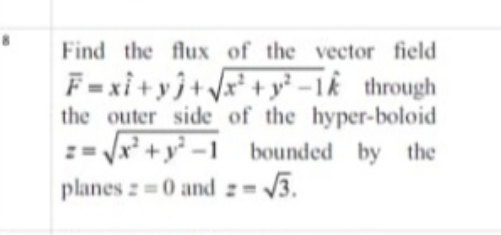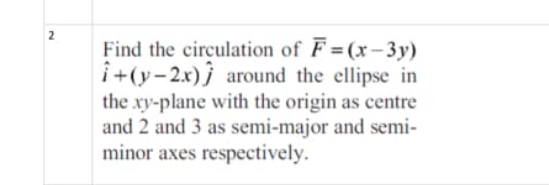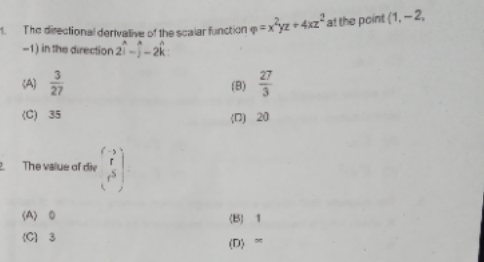
Question and Answers Forum
Vector CalculusQuestion and Answers: Page 3









|
Question and Answers Forum |
Vector CalculusQuestion and Answers: Page 3 |

|
| find∫∫_S ▽×F .n^ ds where F^→ =y^2 i^ +yj^ −xzk^ and S is the upper half of the sphere x^2 +y^2 +z^2 =a^2 |
| find the flux of the vector field F=xi^ +yj^ +(√(x^2 +y^2 −1 k^ )) through outer side of hyper−boloide z=(√(x^2 +y^2 −1)) bounded by the planes z=0 and z=(√3) |
| ∫∫∫_V ▽×F dV where F=(x+2y)i^ −3zj^ +xk^ and V is the closed region in first octant by the plane 2x+2y+2z=4 |
| verify the gauss divergence theorem f=(x^2 −yz)i^ +(y^2 −zx)j^ +(z^2 −xy)k^ over the region R bounded by the parallelepiped 0≤x≤a,0≤y≤b, 0≤z≤c |

|

|

|

|

|
| N=x32y in base 10. N≡0[3] and N≡0[4]. N>8329 N has four digits. Determinate N. |
| Given { ((u_0 =5)),(( u_(n+1) =3u_n −4)) :} 1. show that ∀ n∈N, u_n =2+3^u_(n+1) a. Deduct that u_n is odd. c. Show that GCD(u_n ;u_(n+1) )=1 d. Deduct GCD(6+3^(1002) ;6+3^(1003) ). GCD=greatest common divisor^ |
| Given a, b ∈[0;4] 309a+15c=226b 1) show that 2b≡0[3] and 3a≡1[5] |
| Given that the forces F_1 , F_2 and F_3 have position vectors r_1 , r_2 and r_3 . Where, F_1 = (2i + 3i + k) N r_1 = (i + 2k) m F_2 = (3i + 2i + 5k) N r_2 = (2i − 4j + k) m F_3 = (−5i−5j −6k) N r_3 = (4i + 3j + 2k) m (a) Find the moment of F_1 about (2i + 3j + 4k) m. (b) Show that this system of forces reduces to a couple, G, and find the magnitude of this couple. (c) Check if F_1 and F_2 are concurrent. |
| N is written 158b687a in base 10. with a<b. show that N≡2+a[4] |
| Nama : Attila Abiem Farhan Kelas : XI BKP Tugas KD 3.18 MTK 1. jawab : u^→ = (((−3)),((−4)),(( 12)) ) ∣u^→ ∣=(√((−3^2 )+(−4)^2 +12^2 )) =(√(9+16+144)) =(√(169))=13 2. jawab : a^→ = ((2),((−1)),(3) ) b^→ = ((7),((13)),(5) ) a^→ +b^→ = ((9),((12)),(8) ) ∣a^→ +b^→ ∣=(√(9^2 +12^2 +8^2 )) =(√(81+144+64)) =(√(289)) 3. jawab u^→ = ((7),(9),((−17)) ) v^→ = (((−2)),((−3)),((19)) ) u^→ −v^→ = ((9),((12)),((36)) ) ∣u^→ +v^→ ∣=(√(9^2 +12^2 +36^2 )) =(√(81+144+1296)) =(√(1521)) 4. jawab : A. 2a^→ = (((−6)),((−8)),((−24)) ) ∣2a^→ ∣=(√((−6)^2 +(−8)^2 +(−24)^2 )) =(√(36+64+576)) =(√(676)) =26 (1/2)b^→ = ((3),(4),((12)) ) ∣(1/2)b^→ ∣=(√(3^2 +4^2 +12^2 ))=(√(9+16+144))=(√(169))=13 B. 4a^→ +b^→ = (((−12)),((−16)),((−48)) ) + ((6),(8),((24)) ) = (((−6)),((−8)),((−24)) ) ∣4a^→ +b^→ ∣=(√((−6)^2 +(−8)^2 +(−24)^2 )) =(√(36+64+576)) =(√(676))=26 5. jawab : u^→ =8i+3k v^→ =5j−9k u^→ .v^→ =(8.0)i+(0.5)j+(3.−9)k =0+0−27k u^→ .v^→ =−27k |
| Show by recurence that: 5^n ≥1+4n ; n∈N |
| find the distance of point (2,1,−2) to plane passing through points (−1,2,−3); (0,−4,−2) and (1,3,4). |

|
| ∫_c (3xy−e^(sin x) )dx+(7x+(√(y^4 +1)) )dy C : triangle with vertex (0,0),(0,1) and (1,0) |

|
| Σ_(n=1) ^∞ (1/(n^3 +1)) |
| find the point of intersection of the line r^→ =(1−2t,3+4t,t) and the plane 3x−2y+5z=15 |

|
| evaluate ∫∫_s (xz+y^2 )dS where S is the surface described by x^2 +y^2 =16 , 0≤z≤3 |
| Un=(1+(√2))^n show that we have p_n ∈N / U_n =(√p_n )+(√(p_n +1)) |